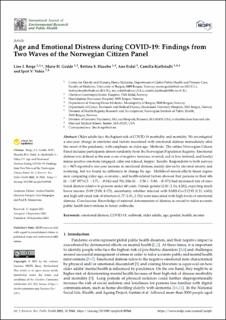| dc.contributor.author | Berge, Line Iden | |
| dc.contributor.author | Gedde, Marie H. | |
| dc.contributor.author | Husebø, Bettina Elisabeth Franziska | |
| dc.contributor.author | Erdal, Ane | |
| dc.contributor.author | Kjellstadli, Camilla | |
| dc.contributor.author | Vahia, Ipsit Vihang | |
| dc.date.accessioned | 2022-01-25T10:18:12Z | |
| dc.date.available | 2022-01-25T10:18:12Z | |
| dc.date.created | 2021-09-17T14:15:00Z | |
| dc.date.issued | 2021 | |
| dc.identifier.issn | 1661-7827 | |
| dc.identifier.uri | https://hdl.handle.net/11250/2839159 | |
| dc.description.abstract | Older adults face the highest risk of COVID-19 morbidity and mortality. We investigated a one-year change in emotions and factors associated with emotional distress immediately after the onset of the pandemic, with emphasis on older age. Methods: The online Norwegian Citizen Panel includes participants drawn randomly from the Norwegian Population Registry. Emotional distress was defined as the sum score of negative (anxious, worried, sad or low, irritated, and lonely) minus positive emotions (engaged, calm and relaxed, happy). Results: Respondents to both surveys (n = 967) reported a one-year increase in emotional distress, mainly driven by elevated anxiety and worrying, but we found no difference in change by age. Multilevel mixed-effects linear regression comparing older age, economy-, and health-related factors showed that persons in their 60s (ß −1.87 (95%CI: −3.71, −0.04)) and 70s/80s (ß: −2.58 (−5.00, −0–17)) had decreased risk of emotional distress relative to persons under 60 years. Female gender (2.81 (1.34, 4.28)), expecting much lower income (5.09 (2.00, 8.17)), uncertainty whether infected with SARS-Cov2 (2.92 (1.21, 4.63)), and high self-rated risk of infection (1.77 (1.01, 2.53)) were associated with high levels of emotional distress. Conclusions: Knowledge of national determinants of distress is crucial to tailor accurate public health interventions in future outbreaks. | en_US |
| dc.language.iso | eng | en_US |
| dc.publisher | MDPI | en_US |
| dc.rights | Navngivelse 4.0 Internasjonal | * |
| dc.rights.uri | http://creativecommons.org/licenses/by/4.0/deed.no | * |
| dc.title | Age and Emotional Distress during COVID-19: Findings from Two Waves of the Norwegian Citizen Panel | en_US |
| dc.type | Journal article | en_US |
| dc.type | Peer reviewed | en_US |
| dc.description.version | publishedVersion | en_US |
| dc.rights.holder | Copyright 2021 by the authors | en_US |
| dc.source.articlenumber | 9568 | en_US |
| cristin.ispublished | true | |
| cristin.fulltext | original | |
| cristin.qualitycode | 1 | |
| dc.identifier.doi | 10.3390/ijerph18189568 | |
| dc.identifier.cristin | 1935459 | |
| dc.source.journal | International Journal of Environmental Research and Public Health (IJERPH) | en_US |
| dc.relation.project | Universitetet i Bergen: 2019/4439 | en_US |
| dc.relation.project | Norges forskningsråd: 273581 | en_US |
| dc.identifier.citation | International Journal of Environmental Research and Public Health. 2021, 18 (18), 9568. | en_US |
| dc.source.volume | 18 | en_US |
| dc.source.issue | 18 | en_US |

